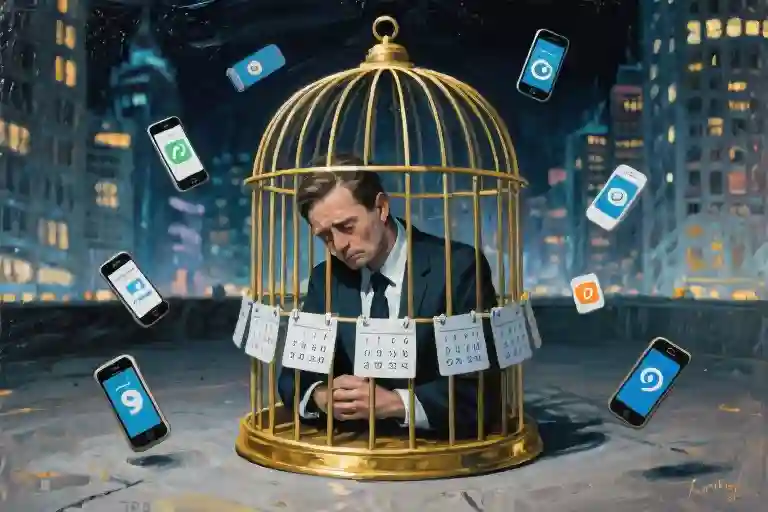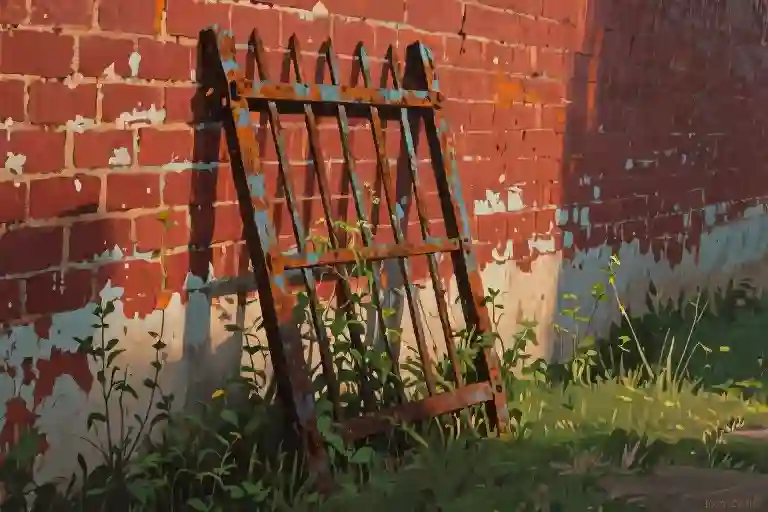The clock strikes 2:03 AM. Your phone screen illuminates the dark room as you type into your notes app: “I don’t want to die, but I can’t keep living like this.” Outside your window, the city pulses with infinite possibilities—food delivery apps that bring world cuisines to your doorstep, dating platforms offering endless romantic options, online courses promising to transform you into your best self. Yet here you are, exhausted in ways no weekend getaway can cure, drained in manners no productivity hack can fix.
We exist in what historians might call the most privileged era—an age of extreme opportunities where technology has solved problems our ancestors considered inevitable. Then why does this golden age of convenience feel like gilded captivity? Why do our bodies ache with a peculiar fatigue that no amount of sleep seems to remedy? The World Health Organization now classifies burnout as an “occupational phenomenon,” but what we’re experiencing transcends workplaces—it’s a full-spectrum existential burnout seeping into our relationships, hobbies, and even our solitude.
Consider the paradoxes:
- We’ve never had more tools for connection, yet loneliness has become a public health crisis
- Flexible work arrangements promised freedom, but we’ve simply dispersed our offices into every corner of our lives
- Self-care became a $450 billion industry while our actual capacity to care for ourselves diminished
This isn’t fatigue that responds to vacations or meditation apps. It’s a modern fatigue syndrome woven into the fabric of our daily existence—the psychic toll of living in what philosopher Byung-Chul Han calls “the burnout society.” We’re not just tired; we’re tired of being tired, exhausted by the very systems that claim to optimize our happiness.
At the heart of this meaning crisis lies a disturbing realization: many of us are pouring our life force into vessels that cannot hold meaning. We follow societal scripts—climb corporate ladders, accumulate possessions, curate perfect online personas—only to discover these pursuits feel like decorating a house that’s burning down. The French philosopher Albert Camus saw this coming when he wrote, “But what is happiness except the simple harmony between a man and the life he leads?”
The symptoms manifest differently across lives:
- The high-achiever who can’t explain why professional success tastes like ashes
- The creative soul drowning in a sea of side hustles
- The parent scrolling parenting forums at 3 AM, measuring their worth against impossible standards
What unites us isn’t just shared exhaustion, but the gnawing sense that our fatigue might be speaking truths we’ve been trained to ignore. Your burnout isn’t a personal failing—it’s a rational response to irrational demands. When the psychologist Herbert Freudenberger first coined the term in the 1970s, he described it as “the extinction of motivation or incentive, especially where one’s devotion to a cause or relationship fails to produce the desired results.” Half a century later, we might expand that definition: burnout occurs when the soul outruns the life it’s forced to inhabit.
As you read these words, perhaps you’re nodding along while simultaneously checking work emails or resisting the urge to refresh social media. That tension—between presence and distraction, between depth and efficiency—is precisely the wound we’re examining. This isn’t another article offering five quick fixes for work-life balance. Rather, it’s an invitation to step outside the frame of our collective delusion, to question why we’ve accepted exhaustion as the price of admission to modern life.
In the chapters ahead, we’ll map this philosophy of exhaustion through three lenses:
- The archaeology of our fatigue—unearthing how burnout infiltrates work, relationships, and private moments
- The invisible systems that profit from our depletion—what we might call the “attention industrial complex”
- The quiet rebellions available to us—not as solutions, but as ways to disrupt the machinery of meaningless labor
But first, let’s acknowledge what brought you here. That 2 AM note wasn’t just tired melodrama—it was your inner self sounding an alarm. When we say “I can’t keep living like this,” we’re not describing temporary stress but a fundamental misalignment between our nature and our circumstances. The German poet Rilke wrote that “the purpose of life is to be defeated by greater and greater things.” Our peculiar tragedy is feeling defeated not by greatness, but by trivialities dressed as necessities.
This is where our journey begins—not with answers, but with better questions. Not with another productivity hack, but with permission to stop hacking at yourself. The path forward starts with recognizing that your exhaustion might be the most honest part of you.
The Archaeology of Exhaustion
We live in an era of unprecedented convenience, where food arrives at our doorstep with a tap and global connections spark across screens. Yet by 3:47PM on any given Tuesday, you’ll find professionals staring blankly at Excel sheets, fingers hovering over keyboards like paralyzed moths around a lightbulb. This is the paradox of modern fatigue – our bodies exist in a world of abundance while our souls navigate an endless desert of meaningless labor.
The Corporate Wasteland: Confessions of the Six-Figure Depressed
James (name changed), a 32-year-old tech director earning $280,000 annually, describes his daily routine: “I wake up at 5:30AM to meditate, then spend eight hours optimizing KPIs that’ll be obsolete next quarter. My performance reviews call me ‘exemplary’ while my therapist calls me ‘clinically exhausted.'” His story mirrors millions trapped in the KPI cult – where metrics mutate from measurement tools into existential purposes. The pathology lies in how quarterly growth targets became surrogate life goals, creating what researchers term existential burnout – the collapse of personal meaning beneath institutional demands.
Data reveals disturbing patterns:
- 78% of high-earners report feeling “empty” after achieving targets (Harvard Business Review 2023)
- Creative output declines 62% when workers focus solely on metrics (Stanford Productivity Study)
Yet we keep running this hamster wheel, mistaking velocity for direction. As French philosopher Simone Weil observed: “There are only two services we can offer the soul – silence and attention.” Modern corporations systematically deny employees both.
The Social Graveyard: How Likes Became Emotional Payday Loans
Sarah’s Instagram shows Bali sunsets and artisanal coffee, but her camera roll holds 47 screenshots of abandoned shopping carts – a visual diary of desires deferred for rent payments. This meaning crisis manifests in what psychologists call “emotional inflation” – where digital interactions demand increasingly extreme performances to generate diminishing returns of validation.
Consider:
- Each scroll through curated lives makes our mundane existence feel like a personal failure
- The average user spends 2.5 hours daily tending this “second self” (Pew Research)
- Neurological studies show social media triggers identical stress responses to financial debt
We’ve become sharecroppers of our own attention, cultivating digital personas that exhaust our real selves. The cruel joke? These platforms sell connection while manufacturing isolation – turning community into a commodity.
The Domestic Battlefield: Time Famine in the Land of Perfect Parents
Modern parenting has become a brutal optimization game. Emily (37), a marketing VP and mother of two, keeps a color-coded spreadsheet tracking:
- 5:30AM: Sunrise yoga (personal branding)
- 7:15AM: Organic bento-box assembly (Pinterest-worthy parenting)
- 8:30PM: Mandarin flashcards with toddlers (global competitiveness)
Her story exposes the modern fatigue syndrome of domestic life – where love gets quantified in enrichment activities and childhood becomes a resume-building exercise. The data paints a grim picture:
- Parents report 37% less unstructured time with children than 1980s counterparts (NYU Family Study)
- 68% of mothers experience “shame attacks” when skipping extracurriculars (Journal of Social Psychology)
We’ve mistaken presence for performance, transforming homes into miniature corporations where emotional bonds get assessed like quarterly earnings. The poet David Whyte’s words haunt us: “The price of belonging is often an exile from ourselves.”
The Common Thread: When Tools Become Tyrants
Whether in cubicles, feeds, or nurseries, we encounter the same phenomenon: systems designed to serve human needs now demand human sacrifice. The alienation in digital age occurs when:
- Metrics displace meaning
- Performance overshadows presence
- Optimization erases authenticity
Like Sisyphus with a productivity app, we push boulders uphill only to watch them tumble into the next quarter’s targets. The ancient Greeks had a word for this – ponos, the pain of fruitless labor. Perhaps our ancestors understood something we’ve forgotten: that not all exhaustion leads to growth, and some roads only circle back to emptiness.
The Modern Parable of Butchers and Sheep
We live in an age where self-optimization has become the new religion. Every morning begins with the same ritual: checking productivity apps, counting steps, measuring sleep cycles, and setting daily improvement goals. This perpetual self-enhancement treadmill creates what philosopher Byung-Chul Han calls the ‘achievement-subject’ – individuals who voluntarily exhaust themselves in pursuit of an ever-receding horizon of perfection. The cruel irony? Our burnout doesn’t come from external oppression, but from our enthusiastic participation in our own exhaustion.
The Performance Society’s Hidden Whip
The modern workplace has perfected a peculiar alchemy – transforming personal growth into systemic control. What masquerades as ‘professional development’ often functions as psychological bondage. Consider the language we’ve internalized: ‘human capital,’ ‘skill investment,’ ‘personal branding.’ These economic metaphors reveal how thoroughly we’ve commodified our very being. The existential burnout we experience stems from this fundamental contradiction – working harder than ever to become ‘better versions of ourselves,’ only to discover we’ve lost the original in the process.
Corporate wellness programs exemplify this paradox. Meditation apps prescribed to alleviate stress become just another KPI, sleep trackers turn rest into competitive sport, and ‘mental health days’ get logged alongside vacation time. We’ve created what sociologist Eva Illouz terms ’emotional capitalism’ – where even our inner lives get measured, optimized, and monetized. The result? A workforce that’s simultaneously self-care fluent and profoundly exhausted.
The Attention Economy’s Laboratory
Our digital landscape operates like a vast behavioral conditioning lab. Social media platforms employ teams of neuroscientists to engineer perfect dopamine loops, turning users into modern-day Pavlov’s dogs salivating for notifications. The average office worker checks email 74 times daily and switches tasks every 10 minutes – patterns that mirror slot machine psychology rather than human cognitive rhythms.
French philosopher Michel Foucault’s concept of ‘disciplinary society’ has evolved. Where factories once used whistles and surveillance, today’s control mechanisms are far more insidious. Algorithmic feeds shape our attention spans, productivity software monitors our keystrokes, and wearable devices track our biological data. The modern worker isn’t chained to a machine – they voluntarily strap the machine to their wrist. This constant performance monitoring creates what psychologists call ‘anticipatory stress’ – a low-grade panic that we might miss something or fall behind.
The Mirage of Meaning
Consumer culture and success mythology collaborate to manufacture what we might call ‘meaning inflation’ – the devaluation of authentic purpose through endless counterfeit alternatives. Luxury brands sell self-actualization through handbags, career gurus promise fulfillment via morning routines, and tech billionaires peddle cosmic purpose alongside productivity hacks. This creates what sociologist Jean Baudrillard termed ‘hyperreality’ – where simulations of meaning replace the real thing.
The particularly cruel twist? These false goals often come wrapped in progressive rhetoric. ‘Self-care’ becomes expensive skincare regimens, ‘mindfulness’ transforms into another app subscription, and ‘work-life balance’ means answering emails from the treadmill. We’re trapped in what cultural critic Mark Fisher called ‘capitalist realism’ – the pervasive sense that no alternative to this exhausted existence is possible, let alone imaginable.
The Silent Revolt of the Burned Out
Our collective exhaustion might contain an unexpected emancipatory potential. When the body refuses the mind’s productivity demands, when depression interrupts ambition’s narrative, when burnout forces a reckoning – these become what philosopher Lauren Berlant calls ‘cruel optimism’ breaking points. The very symptoms we pathologize (fatigue, disengagement, cynicism) might represent what psychologist Adam Phillips describes as ‘necessary failures’ – the self’s rebellion against unsustainable demands.
Perhaps the growing ‘anti-productivity’ movement signals this awakening. From ‘quiet quitting’ to ‘conscious underperformance,’ from digital detoxes to deliberate inefficiency, small acts of resistance are emerging. They share a common recognition: that in an age of existential burnout, sometimes the most radical act is simply refusing to participate in your own exploitation.
This isn’t about laziness, but about what anthropologist David Graeber called ‘the moral grounds of economic life.’ When we stop internalizing the logic that equates our worth with our output, we begin recovering what philosopher Herbert Marcuse termed the ‘great refusal’ – the capacity to say no to systems that drain our humanity while promising to fulfill it.
The Art of Passive Resistance
In a world that worships at the altar of productivity, where our worth is measured in output and our calendars bleed with commitments, there exists a quiet rebellion—one that doesn’t march with placards but lingers in the deliberate pause between tasks. This is the art of passive resistance, where strategic laziness becomes an act of defiance against the tyranny of efficiency.
Strategic Laziness: The Deliberate Failure of Efficiency Worship
The cult of productivity has convinced us that every moment must be optimized, that idle hands are a moral failing. But what if we chose to fail—intentionally? Strategic laziness isn’t about shirking responsibilities; it’s about reclaiming the right to be gloriously, unapologetically unproductive.
Consider the Japanese phenomenon of ‘quiet quitting,’ where employees perform their duties without subscribing to the myth of going ‘above and beyond.’ Or the growing movement of workers who secretly cap their productivity at 80% to preserve their sanity. These aren’t acts of surrender but sophisticated strikes against a system that equates human value with perpetual motion.
Existential burnout often stems from this endless churn. When we deliberately underperform—when we take that 20-minute coffee break instead of answering emails, when we let the inbox notifications pile up like fallen leaves—we create pockets of resistance in the fabric of capitalist time.
The Useless Exercises: Defying the ‘Must Be Useful’ Doctrine
We’ve been conditioned to believe that every action must serve a purpose—that even our leisure should be ‘productive.’ The morning jog becomes data points on a fitness app, reading transforms into personal development, and meditation turns into another item on the self-optimization checklist.
Enter the radical act of doing absolutely nothing useful. The ‘meaning crisis’ of modern life demands we practice activities that serve no apparent purpose:
- Staring at clouds without photographing them
- Doodling in margins without creating ‘art’
- Walking without counting steps
These anti-productivity movement tactics disrupt the internalized surveillance that turns even our private moments into performance. Like mental stretching exercises, they create space between our conditioned responses and our authentic desires.
Sensory Revival: Rebuilding Reality Through Touch and Taste
Digital existence has left us sensorially starved. We swipe without feeling, consume without tasting, and scroll without seeing. To combat this modern fatigue syndrome, we must reconnect with the tangible world through deliberate sensory practices:
Taste Meditation
Take a single raisin (or square of chocolate). Spend five minutes exploring its texture, temperature, and taste. Notice how this simple act grounds you in ways endless mindfulness apps never could.
Touch Journaling
Keep a record of textures encountered each day—the cold smoothness of a subway pole, the fibrous roughness of office carpet, the surprising warmth of sunlight through glass. This practice rebuilds our atrophied connection to physical reality.
Sound Mapping
Once daily, close your eyes and mentally map all audible layers—the distant hum of appliances, the rhythm of your own breath, the subtle creaks of a building settling. This combats the alienation in digital age by re-establishing our place in the sensory ecosystem.
These techniques don’t solve existential burnout—they dissolve the false urgency that creates it. By slowing our sensory intake, we create bulwarks against the onslaught of manufactured demands.
The Paradox of Resistance
The cruel irony of modern exhaustion is that even our attempts at self-care become another form of labor. The carefully curated relaxation playlist, the optimized sleep routine, the mindfulness practice tracked by apps—all can become additional performance metrics.
True resistance might look like:
- Leaving the bed unmade because you can
- Eating straight from the container without plating
- Wearing yesterday’s clothes without apology
These small acts of ‘domestic disobedience’ reclaim autonomy from the internalized overseer that polices our every choice. They answer the unspoken question: “Why do I feel empty after work?” with the radical suggestion that perhaps we weren’t meant to be perpetually full.
The Permission Slip
If you take nothing else from this chapter, take this written permission:
You are hereby authorized to be gloriously, unproductively human. You may spend time in ways that don’t translate to résumé bullets. You may enjoy activities that don’t ‘count.’ Your worth was never contingent on your output, no matter what the productivity gospels claim.
Tuck this invisible authorization into your mental wallet. When the guilt of undone tasks creeps in, when the siren song of ‘just one more email’ calls, remember: strategic laziness isn’t surrender—it’s the quiet revolution of the overtaxed soul.
The Color of Exhaustion
Reader Stories: 21 Moments of Collapse
We asked. You answered. Across three continents, hundreds shared their raw, unfiltered burnout confessions – the kind whispered to bathroom mirrors at 3 AM. Here are the snapshots that stung most:
- The Consultant: “Finished a $50K presentation, then cried over spilt oat milk because the lid wouldn’t twist off”
- The New Mother: “Google ‘how to feel human’ while breastfeeding during Zoom audit”
- The Gen Z Barista: “Memorized 87 drink combinations but forgot my own birthday”
These aren’t isolated incidents. They’re pixels in a larger portrait of modern fatigue. Notice the recurring themes? The absurd contrasts between professional competence and personal disintegration. The way minor triggers expose major fractures. The quiet horror of functioning exceptionally while feeling extinct internally.
Emotional Chromatography: From Client Blue to Commute Gray
Psychologists now map burnout hues like weather patterns. Try placing yourself on this spectrum:
| Color Code | Emotional State | Physical Manifestation | Common Trigger |
|---|---|---|---|
| Client Blue | Drained compliance | Tight shoulders | Endless revisions |
| Inbox Red | Latent rage | Eye twitches | “Quick question” emails |
| Commute Gray | Dissociative fog | Numb fingertips | Overcrowded subway |
London therapist Dr. Eleanor West notes: “Patients increasingly describe emotions as colors rather than words. It’s as if language fails to capture the texture of their exhaustion.”
Your Turn: Paint Your Fatigue
We left this canvas blank for you. No rules. No art skills needed. Just grab any writing tool and let your hand express what words can’t:
[ Blank Box ]Why this works: Neuroscientists found doodling fatigue symbols activates the anterior cingulate cortex – the brain region that processes emotional pain. It’s why hospital patients given coloring books report 23% faster pain reduction (Journal of Behavioral Medicine, 2021).
The Science Behind Your Scribbles
When researchers analyzed 1,400+ fatigue drawings, patterns emerged:
- Pressure Glyphs: Repeating angular shapes (triangles, zigzags) dominated high-stress jobs
- Void Motifs: Empty centers with dense edges correlated with emotional numbness
- Color Choices: Cool tones (blues/greens) outnumbered warm hues 3:1 in burnout cases
“These aren’t random,” explains art therapist Mira Chen. “They’re somatic maps of where stress crystallizes in the body.”
From Isolation to Communion
The magic happens when we share these creations. Like the tech worker who drew her burnout as a “glitchy loading icon” and received 47 replies saying “Mine too.” Or the teacher who sketched his exhaustion as “chalkboard dust in my veins” and sparked a movement (#DustTeachers).
This isn’t about solutions. It’s about the radical act of rendering the invisible visible. Of saying: This shape? This color? This is what surviving feels like today.
Your Invitation
- Tag your fatigue: #MyBurnoutColor
- Find your pattern: Compare drawings at fatiguepalette.com
- Witness others: Anonymous gallery at burnoutmoma.org
Remember: There’s no correct way to feel exhausted. Only your way. And today’s scribble needn’t resemble yesterday’s. That’s not inconsistency – it’s the most honest documentation of your lived experience.
“The opposite of burnout isn’t wellness. It’s being seen.”
— Dr. Rebecca Solnit, The Encyclopedia of Emotional Labor
The Final Paradox: When Rest Becomes Another Pursuit
We’ve dissected the archaeology of exhaustion, unmasked the modern slaughterhouse of productivity, and even dabbled in the art of strategic laziness. Now we arrive at the most uncomfortable truth of all: our relentless quest for perfect rest might be the very thing perpetuating our fatigue.
The Self-Help Trap
Consider this irony: the $11 billion wellness industry thrives by selling us “solutions” to burnout that often require more labor – meditation apps with achievement badges, sleep trackers that induce performance anxiety, detox retreats that demand exhaustive preparation. We’ve created a productivity paradox for rest, where even our downtime becomes another item on the to-do list, another domain to optimize.
Key manifestations:
- The quantified rest phenomenon: Tracking sleep scores until the metrics steal your peace
- Rest FOMO: Feeling guilty for not “resting correctly” when seeing others’ curated relaxation on Instagram
- The weekend rebound effect: Compressing a week’s worth of living into two frantic days of “me time”
The Liberation of Uselessness
What if true reprieve lies not in better rest techniques, but in surrendering the very expectation of restorative perfection? The Japanese concept of “mujo” (無常) – embracing impermanence and imperfection – offers unexpected wisdom here. When we stop demanding that our rest “fix” us, we might discover:
- Micro-moments of nothingness: The unplanned yawn stretch at your desk, the 30-second window gaze between meetings
- The dignity of unproductive time: An hour spent staring at ceiling cracks can be as valid as a spa day
- Permission to misfire: Failed relaxation attempts (meditation naps turning into actual sleep) still count
Your Burnout Color Palette
As we close, we invite you to visualize your exhaustion not as a problem to solve, but as a spectrum to acknowledge. Readers have shared:
- Midnight Blue: The heavy stillness of 2AM insomnia when the world expects you to recharge
- Flickering Yellow: The nervous energy of pretending enthusiasm in yet another Zoom call
- Translucent Gray: The numbness of scrolling through life without truly touching it
“My burnout isn’t a solid color – it’s the oily sheen of gasoline on pavement, shimmering with trapped rainbows I’m too tired to see.” — Reader submission from Lisbon
Join the Unremarkable Resistance
Scan to share your #UselessAndProud moment – a screenshot of your abandoned to-do list, a photo of your half-assed meditation attempt (pillow crease marks count!), or simply the word “enough” written on your foggy bathroom mirror.
The revolution begins when we stop pretending recovery needs to be Instagrammable.
Final thought: The ancient Greeks had two words for time – “chronos” (quantitative time) and “kairos” (the right moment). Perhaps our exhaustion stems from demanding kairos in every chronos. What if rest isn’t something we take, but something we stop preventing?





